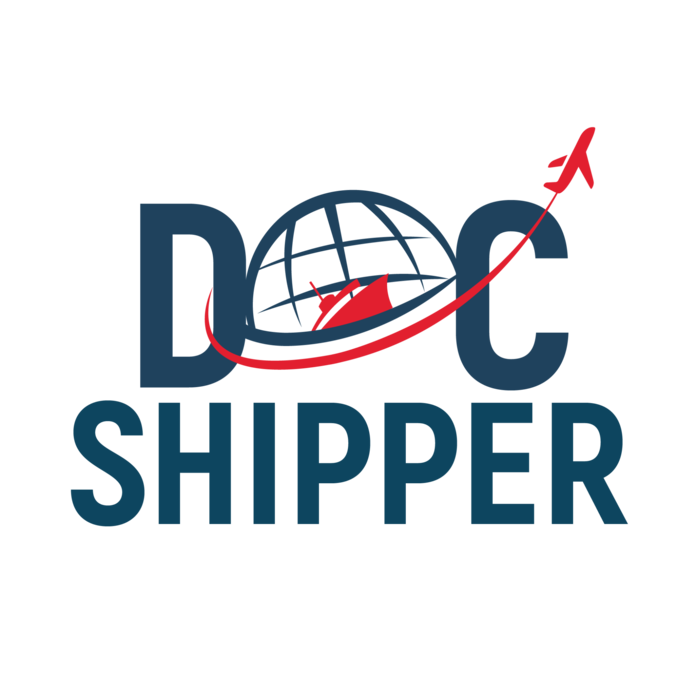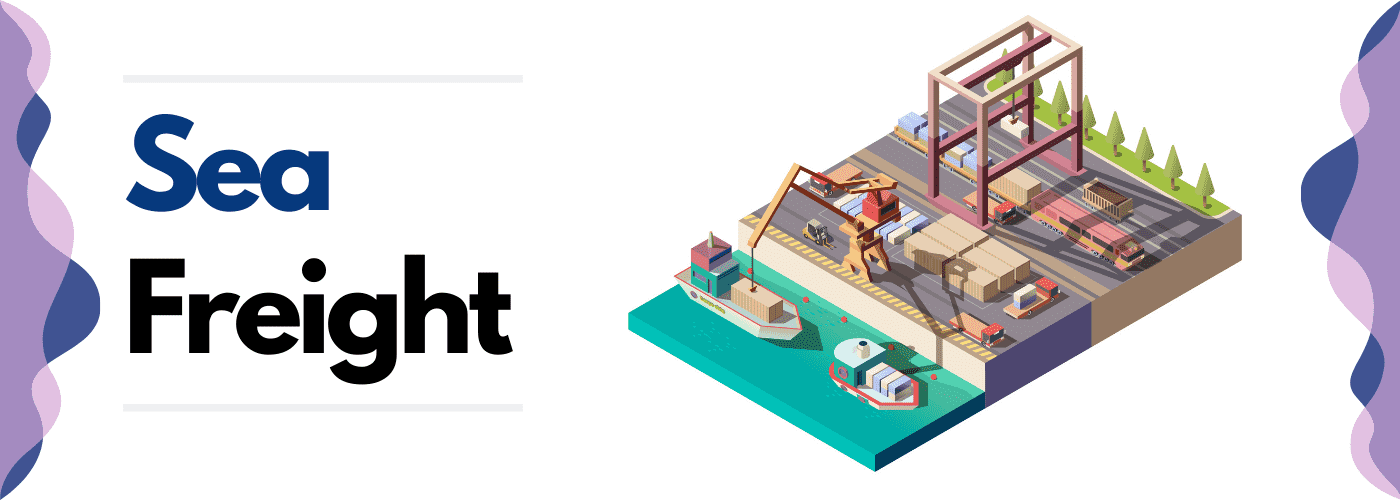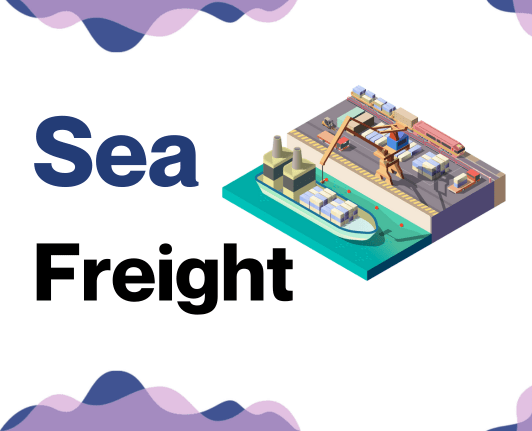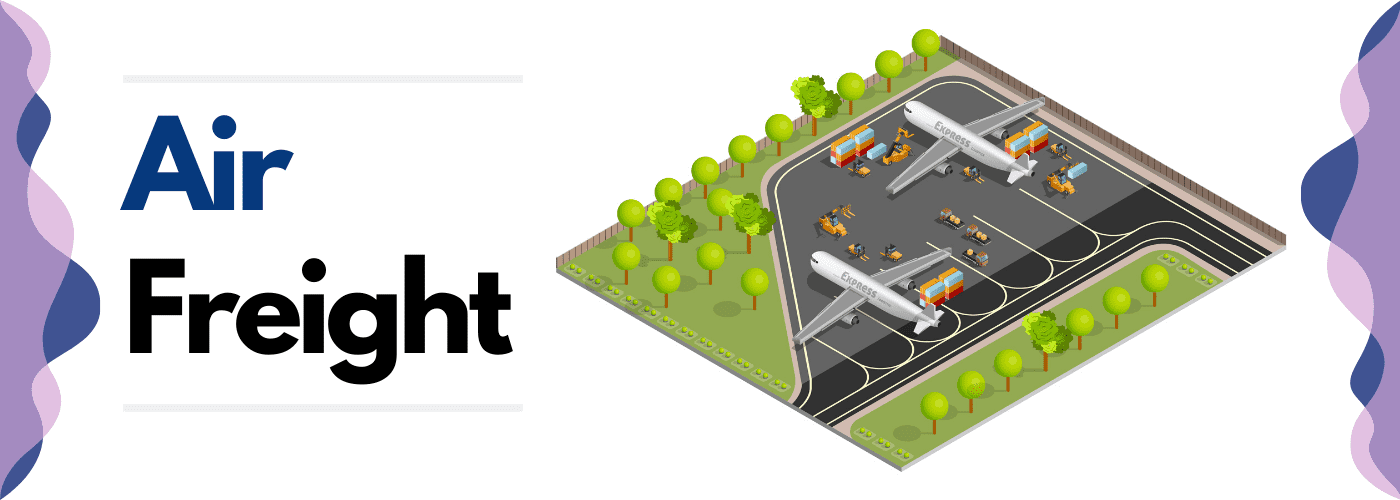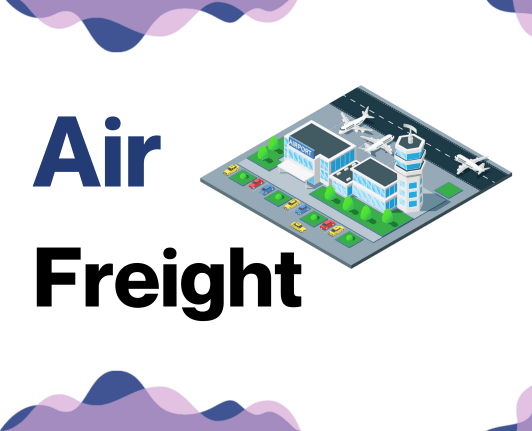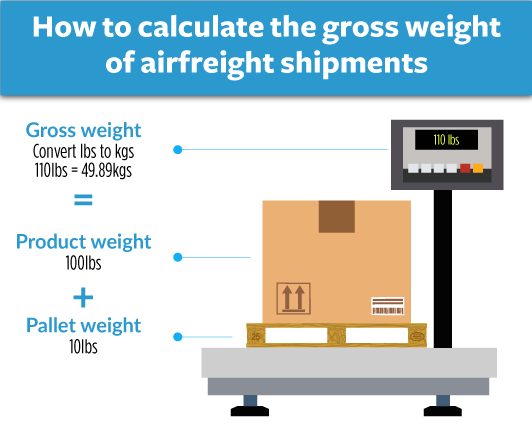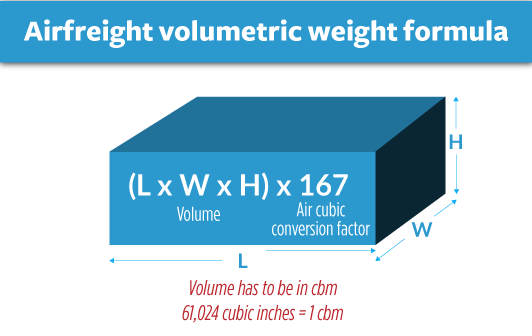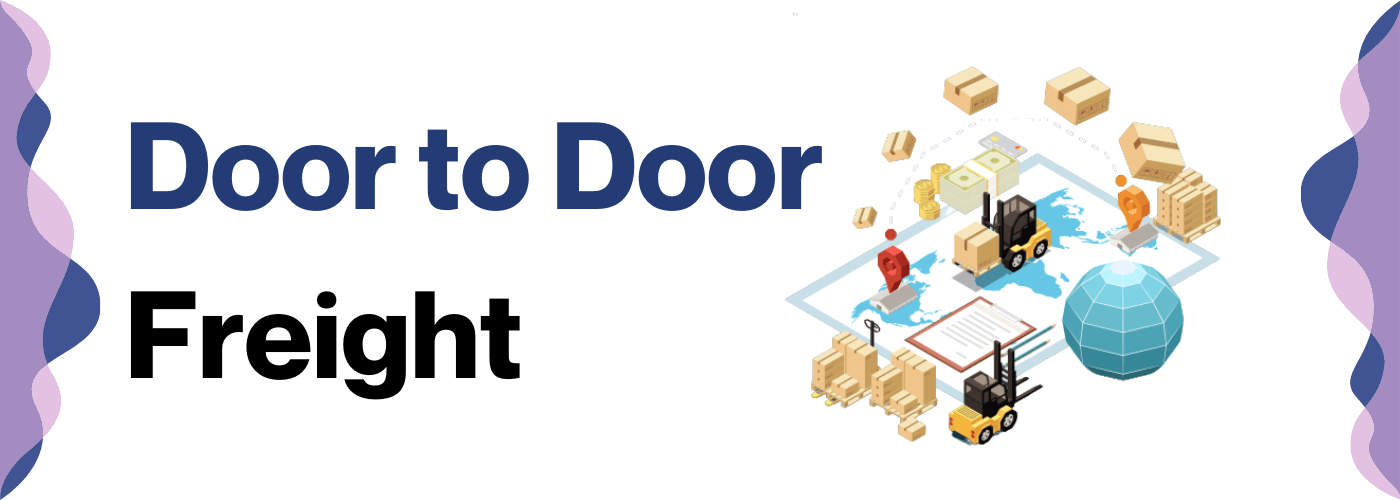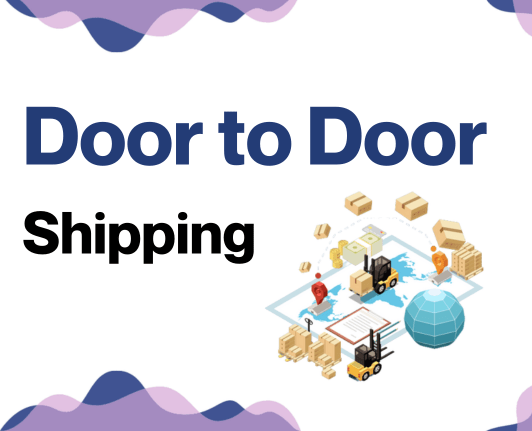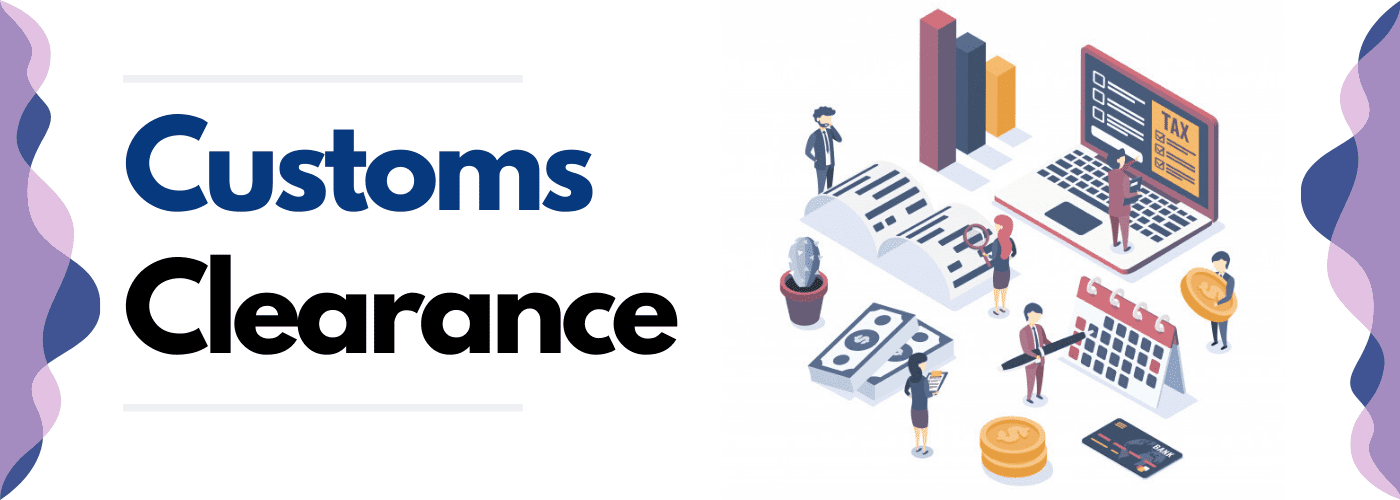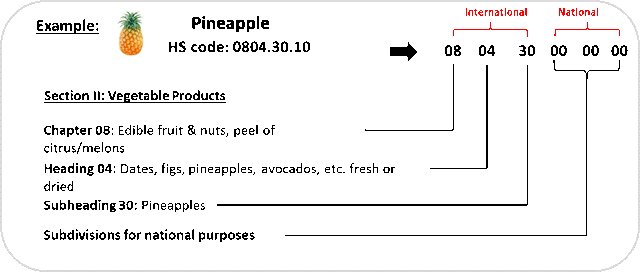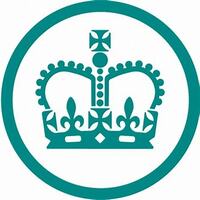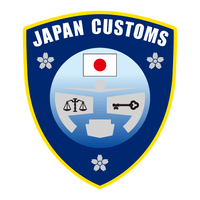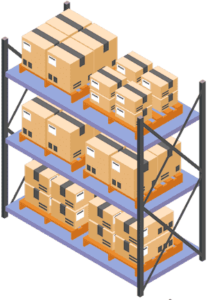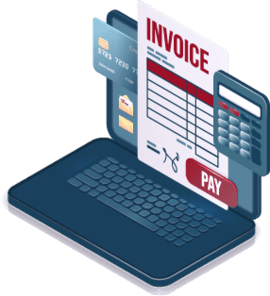Why did the parcel go to therapy? Because it had a lot of 'baggage'! Moving on, managing freight transport between the UK and Japan can feel like wrestling with a similar stack of baggage - complex rates, long transit times, and intricate customs regulations! This guide is designed to simplify the process, covering everything from air and sea freight options to the ins-and-outs of customs, duties, and taxes. Tailored advice ensures that, regardless of your business's size or sector, you'll find fruitful insights to streamline your shipping process. If the process still feels overwhelming, let DocShipper handle it for you! As experts in international freight forwarding, we transform these daunting tasks into your next success story!
Table of Contents
Which are the different modes of transportation between UK and Japan?
Choosing the best method to ship goods between the UK and Japan can be like picking the fastest horse for a long-distance race. Geography plays a critical role here, with oceans and continents acting as hurdles. Given the sprawling distance and location, air and sea transport emerge as efficient racers. Are you after the speed of a falcon or the capacity of a cargo ship? Remember, aligning your choice with your specific shipping needs can turn your transport choice from a simple workhorse to a race-winning champion. It's about making the world smaller, one shipment at a time.
How can DocShipper help?
Shipping between the UK and Japan? DocShipper is your ideal partner. We manage the whole process - from crating to customs clearance. Our team prides itself on transparency, affordability, and speedy service. Got a query? Our consultants are just a phone call away. Claim your free estimate in under 24 hours today!
DocShipper Tip: Ocean freight might be the best solution for you if:
- You're dealing with large quantities or oversized items. Sea freight offers a budget-friendly way to maximize space, a particularly useful option given the UK's extensive port network.
- Your shipment isn't on a tight schedule. Ocean transport typically takes longer than air or rail, but it offers reliability.
- Your supply chain involves key ports, allowing you to take advantage of a wide-reaching network of sea lanes.
Sea freight between UK and Japan
Discover the bustling highway of maritime trade connecting the UK and Japan! With economic ties that have rapidly grown over the years, sea freight across the vast oceans bridges the gap between these global industrial hubs. Busy cargo ports, like Yokohama in Japan, and Southampton in the UK, are the lifeblood of this trade network where countless high-volume goods are exchanged daily. Ocean shipping climbs the ranks as the most cost-effective method, despite its slow pace. But beware, it's not always smooth sailing.
We know the struggle. Mistakes are made, challenges arise, and businesses are left bamboozled when sending shipments on this route. Sounds familiar? That's where we step in. Be the captain of your ship! Dive into this guide to understand the nitty-gritty of ocean shipping between the UK and Japan. By following best practices and specifications detailed in these pages, you'll be navigating these vast trade waters like an old sea dog, avoiding potential pitfalls. Treasure map? Check. Trusted compass? Check. Let's embark on this freight-forwarding journey together!
Main shipping ports in UK
Port of London
Location and Volume: Located on the River Thames, this port is essential for both historical and commercial reasons. It boasts a shipping volume that puts it amongst the top three UK ports, handling over 50 million tonnes of cargo annually.
Key Trading Partners and Strategic Importance: Main trading partners include Europe, the Americas, and Asia. The strategic location, close to London, offers convenient distribution routes across the United Kingdom and into Europe.
Context for Businesses: If you're looking to do business in the United Kingdom or across Europe, the Port of London could fit seamlessly into your logistics due to its excellent transport links and global network.
Port of Southampton
Location and Volume: Situated on England's south coast, Southampton is the UK's number one vehicle handling port, moving approximately 900,000 units each year. Its total annual shipping volume is over 1 million TEU.
Key Trading Partners and Strategic Importance: It has key trading ties across Europe, the Americas, and far East Asia. The port is also a crucial transshipment hub for goods traveling to and from the east coast of the United States.
Context for Businesses: If you are in the automobile or retail industry, with a global supply chain centered around these areas, the Port of Southampton serves as a strategic logistic solution due to its vast vehicle and cargo handling capacity.
Port of Felixstowe
Location and Volume: Located in Suffolk on the eastern coastline, this port handles over 4 million TEUs annually, making it the busiest container port in the UK.
Key Trading Partners and Strategic Importance: Main trading partners include China, other parts of Asia, and many European Union countries. The port is of strategic importance as it functions as a vital gateway to Europe for Asian manufacturing goods.
Context for Businesses: If your business leans heavily on import and export with Asia and Europe, Felixstowe can provide economical and strategic benefits with its high frequency of mega-ship visits and superior connectivity.
Port of Liverpool
Location and Volume: Sitting on the estuary of the River Mersey, it annually moves around 34 million tonnes of cargo.
Key Trading Partners and Strategic Importance: Key trading partners consist of North America, Africa, Asia, and the rest of Europe. The port functions not just as a shipping point but also as a logistical hub for the entire North of England.
Context for Businesses: The Port of Liverpool's centralized location and infrastructure make it ideal if you're seeking efficient distribution and logistics across the North of England and beyond.
Port of Grimsby & Immingham
Location and Volume: Positioned on the Humber Estuary, these two ports combine as the UK's busiest port by tonnage, handling nearly 60 million tonnes each year.
Key Trading Partners and Strategic Importance: The port serves mostly Northern Europe, Scandinavian and Baltic countries, and is crucial for importing energy resources.
Context for Businesses: If you operate in energy sector and regions of North Europe, the Port of Grimsby & Immingham will offer a streamlined logistics solution with their specialized handling of liquid and dry bulk commodities.
Port of Dover
Location and Volume: Located at the narrowest part of the English Channel, it is the busiest passenger port in the UK and handles over 2.5 million trucks per year.
Key Trading Partners and Strategic Importance: It has predominantly European connections, particularly with France. Its strategic significance is as Europe's gateway, making it important for the fast flow of goods.
Context for Businesses: If your focus is on speedy delivery and you're primarily dealing with European partners, the Port of Dover's rapid transit times and high frequency services are attractive aspects of your shipping strategy.
Main shipping ports in Japan
Port of Tokyo
Location and Volume: Located in Tokyo Bay, this is Japan's busiest port in terms of volume. Serving as a significant gateway to Japan’s economy, it offers functions as a distribution and logistics hub. The Port of Tokyo handles about 100 million tons of goods yearly.
Key Trading Partners and Strategic Importance: This port has notable ties with key nations including China, the U.S.A, and various Southeast Asian countries. Tokyo's strategic location in the Pacific Ocean serves as a profound international trading center, connecting global markets.
Context for Businesses: If you're aiming to build robust connections with key Asian markets and the Pacific, the Port of Tokyo provides an excellent opportunity due to its large volume handling capacity and strategic location.
Port of Yokohama
Location and Volume: Based in Kanagawa Prefecture in the Greater Tokyo Area, the Port of Yokohama plays a significant role in maritime trade, with an annual shipping volume of about 3 million TEUs.
Key Trading Partners and Strategic Importance: The port is a crucial link for businesses importing from or exporting to the US, China, and Southeast Asian countries. It is also an important logistic route for Motor Vehicle shipping because of the presence of numerous Japanese vehicle manufacturers in the surrounding region.
Context for Businesses: Considering your need for automobile parts logistics or linking with the massive markets of China, the U.S.A., and ASEAN countries, the Port of Yokohama is an appropriate selection for your business.
Port of Kobe
Location and Volume: Located on Osaka Bay, the Port of Kobe is Japan's fourth-largest container port, with an annual volume of over 3 million TEUs.
Key Trading Partners and Strategic Importance: The Port of Kobe holds a strong trading relationship with China, South Korea, the U.S.A, and Southeast Asian countries, making it a significant hub for international businesses.
Context for Businesses: Should you be seeking expansion within multipolar markets - the Port of Kobe, with its versatile trading partners, acts as an extensive platform, crucial for your growth.
Port of Nagoya
Location and Volume: The Port of Nagoya, located at the geographic center of Japan, is the largest and busiest trading port in Japan in terms of cargo tonnage, annually processing around 200 million tonnes.
Key Trading Partners and Strategic Importance: The port’s central location and diverse cargo handling capabilities make it a strategic link with key trading partners like China, Thailand, and the U.S.A.
Context for Businesses: If you're looking to connect various product channels with premier international markets, the Port of Nagoya could serve as your key logistics hub.
Port of Osaka
Location and Volume: Situated at the mouth of Yodo River in Osaka Bay, the Port of Osaka plays a pivotal role in balancing shipping needs. Handling over 90 million tons of cargo per year, it ranks as the third-largest port in Japan.
Key Trading Partners and Strategic Importance: The port serves as a connecting point for major economies like China, the U.S.A., and several Southeast Asian nations.
Context for Businesses: If your business seeks to distribute goods across diverse areas, the Port of Osaka can serve as an advantageous location due to its ability to handle various types of cargo.
Port of Hakata
Location and Volume: Positioned in Fukuoka City, the Port of Hakata is pivotal for logistics given its geographical advantage as the nearest Japanese port to the Asian continent, dealing with over 17 million tons of cargo a year.
Key Trading Partners and Strategic Importance: The Port of Hakata maintains significant trade relationships primarily with China, Korea, and Singapore.
Context for Businesses: If you're targeting growth in Asian markets and quick turnarounds, this port could prove to be a strategic choice due to its proximity to other Asian countries combined with well-established trading partnerships.
Should I choose FCL or LCL when shipping between UK and Japan?
When shipping goods between the UK and Japan, your choice between Full Container Load (FCL) or Less than Container Load (LCL) - also known as consolidation - could make all the difference. This decision will not only affect your cost and delivery time but can also influence the outcome of your entire shipping operation. Let's explore these sea freight options, their intricate differences, and how to choose strategically to suit your specific needs in the global marketplace. Get ready to power your business logistics with informed decisions!
LCL: Less than Container Load
Definition: LCL (Less than Container Load) shipping is a cost-effective option for transporting smaller volumes of freight. It entails consolidating with other cargo on a shared container to optimise space.
When to Use: This is particularly beneficial for shipments with a volume less than around 13-15 cubic meters (CBM), where a full container would not be fully utilised.
Example: For instance, if you are a UK-based auto parts manufacturer needing to send a consignment of 10 CBM to a client in Japan, LCL shipping is ideal. Your goods will be carefully packed and consolidated with other shipments, optimizing resources and keeping your costs down.
Cost Implications: As the name suggests, the LCL freight option only charges based on the space your cargo occupies. The overall cost can be quite flexible due to the variability in the amount of your goods. Furthermore, as LCL shipment costs also include charges for haulage, customs clearance, and other administrative procedures, you have fewer unexpected additional charges to worry about when compared to other shipping options.
FCL: Full Container Load
Definition: FCL, or Full Container Load, is a shipping option wherein an entire container is dedicated to a single sender’s goods, offering a safer transportation method.
When to Use: FCL shipping is the go-to option when you have a substantial volume of goods to transport - typically more than 15 CBM. This owes to cost-efficiency as well as the fact that your cargo remains sealed in the same container from the point of origin to the destination, enhancing safety.
Example: For instance, imagine you are a UK based automotive parts manufacturer intending to ship a large assortment of parts to your customer in Japan. Opting for a 20'ft or 40'ft FCL container would provide stability and ensure that all components reach the destination unscathed. This not only safeguards your goods but also upholds your business reputation.
Cost Implications: Though an FCL shipping quote is higher than LCL (Less than Container Load), the cost per unit shipped is significantly lower when dealing with large quantities. So, while you might shell out more upfront, the long-term value justifies the FCL container expense.
Unlock hassle-free shipping
Looking to unlock the complexities of freight forwarding between the UK and Japan? At DocShipper, we're committed to making cargo shipping a breeze for businesses. Our team of ocean freight experts will guide you in selecting the perfect shipping option, be it consolidation or full container, based on cost efficiency, cargo size, timeline needs, and security. Ready to embark on a hassle-free shipping journey? Take the first step and claim your free estimate today. Connect with us now!
How long does sea freight take between UK and Japan?
Shipping from the UK to Japan by sea freight typically has an average transit time of around 30 to 40 days. The exact timeframe, however, depends on several factors such as the specific ports used, volume and nature of the goods. For a more accurate estimate tailored to your specific requirements, it's always best to contact a freight forwarder like DocShipper.
Here's an overview of the average transit times for sea freight between some of the main ports in both countries:
| UK Port | Japan Port | Average Transit Time |
| London | Yokohama | 40 |
| Southampton | Nagoya | 38 |
| Liverpool | Kobe | 40 |
| Felixstowe | Tokyo | 36 |
Please note that these are approximate timings and can vary depending on a variety of factors.
How much does it cost to ship a container between UK and Japan?
Estimating the shipping cost between the UK and Japan is akin to finding a perfectly-shaped pebble on a beach - each quote differs just as every pebble does. That's because a bevy of factors can tip the scale: Point of Loading, Point of Destination, the shipping carrier, the nature of the goods, and even the capricious fluctuations of the monthly market. Ocean freight rates, for example, can oscillate enormously. Nonetheless, fret not over the seeming unpredictability! Our seasoned shipping specialists don't peddle one-size-fits-all rates. Instead, they dive deep into your unique shipping needs and curate a cost-effective plan for you, hand-picked like that elusive perfect pebble. Your case is always our command!
Special transportation services
Out of Gauge (OOG) Container
Definition: An OOG container, also known as Out of Gauge cargo, is a shipping container designed to transport bulky items that can't fit into standard containers due to their size or shape.
Suitable for: This shipping option is perfect for oversized cargo such as machinery or large equipment.
Examples: Examples of goods suitable for OOG containers include large-scale construction equipment, industrial machinery, or windmill blades.
Why it might be the best choice for you: If you deal in oversized goods, this might be your best choice. DocShipper can expertly handle the loading, securing, and shipment of these goods to and from the UK and Japan.
Break Bulk
Definition: Break bulk involves the shipment of cargo as individual pieces rather than in containers. This allows the goods to be individually loaded onto the shipping vessel.
Suitable for: Break bulk is suitable for cargo that's too large or heavy to fit into containers but can withstand exposure to elements.
Examples: These might include construction materials such as steel beams, large vehicle parts, or heavy machinery.
Why it might be the best choice for you: If your business revolves around large, heavy, and durable goods, then break bulk can simplify your logistics.
Dry Bulk
Definition: Dry bulk refers to the transport of large quantities of loose cargo load, such as grains or minerals, not packaged separately.
Suitable for: It's ideal for small, loose items that can be directly dumped or poured into a ship's hold.
Examples: Typical dry bulk goods comprise coal, grain, or sand.
Why it might be the best choice for you: If your business involves dealing with small, loose goods in large quantities, opting for dry bulk shipping can be cost-effective and efficient.
Roll-on/Roll-off (Ro-Ro)
Definition: Roll-on/Roll-off, commonly referred to as Ro-Ro, uses vessels specifically built to carry wheeled cargo which are driven on and off the ship on their own wheels or, in the case of trailers, using a ro-ro vessel's built-in ramps.
Suitable for: Ro-Ro is ideal for wheeled cargo such as cars, trucks, semi-trailer trucks, trailers, and railroad cars.
Examples: Vehicles, whether personal, commercial, or specialty vehicles like ambulances, make up the majority of Ro-Ro shipment goods.
Why it might be the best choice for you: If your enterprise involves the shipment of vehicles or trailers between the UK and Japan, Ro-Ro presents a secure and efficient option.
Reefer Containers
Definition: Reefer containers, or refrigerated containers, are used for goods requiring temperature-controlled conditions.
Suitable for: Mainly for foods, pharmaceuticals, and any other goods that need to be preserved in a climate-controlled environment during transit.
Examples: Items like frozen foods, dairy products, medicines, flowers, or plants are typically shipped in reefer containers.
Why it might be the best choice for you: If your business deals with perishable products, opting for reefer containers will ensure your goods reach their destination without spoiling.
Remember, at DocShipper, we understand the complexities of international logistics and are ready to navigate them for you. Contact us to receive a free shipping quote in less than 24 hours.
DocShipper Tip: Air freight might be the best solution for you if:
- You're facing tight deadlines or need rapid delivery. Air freight is your quickest option, which aligns well with the fast-paced business environment.
- Your shipment is relatively small, under 2 CBM. Air freight is ideal for these more compact loads.
- Your cargo's destination isn't easily reached via sea or rail. This makes air freight a viable option, especially given the extensive network of airports available.
Air freight between UK and Japan
When shipping from UK to Japan, air freight stands out as a swift and dependable method, especially for lightweight, high-value goods. Imagine sending a package of luxury watches or crucial medical supplies - both perfectly suited for the speed and safety offered by air freight. Despite the slightly elevated costs, it shines for smaller shipments, where time is worth more than money.
However, like flying a kite in a hurricane, many shippers dive head-first into air freight without knowing the nuances, leading to costly errors. Missteps such as incorrectly calculating freight weight can cause budget overruns as hefty as an overstuffed suitcase. But fret not! We'll uncover these common pitfalls and arm you with best practices to steer clear of unwelcome surprises.
Air Cargo vs Express Air Freight: How should I ship?
Wondering how to zoom your goods across the skies from the UK to Japan? It can be a tough call deciding between Air Cargo, stowed away with other luggage in an airline, and Express Air Freight, taking a solo flight in a dedicated plane. While both are fast, quick isn't always king, and multiple factors inevitably play into this sky-high decision. With this guide, find clarity on how to match the perfect air transportation option to your business needs.
Should I choose Air Cargo between UK and Japan?
Deciding on air cargo for your UK-Japan shipments can be a wise move. This mode of transport, operated by leading airlines like British Airways and Japan Airlines, offers cost-effectiveness and reliability. Despite longer transit times due to fixed schedules, it becomes particularly attractive if your shipments exceed 100/150 kg (220/330 lbs). You'll find this choice suits your budget while ensuring your cargo reaches its destination as planned. It's a trustworthy solution to meet your international logistics requirements.
Should I choose Express Air Freight between UK and Japan?
Express air freight involves exclusive cargo planes - no passengers. Perfect for loads under 1 CBM or 100/150 kg (220/330 lbs), this service might be right for you. It's fast, efficient, and offered by trusted international couriers. FedEx, UPS, and DHL stand out in providing this advanced logistics solution. Consider this method for urgent shipments from the UK to Japan to ensure speedy and secure delivery.
Main international airports in UK
London Heathrow Airport
Cargo Volume: Handles over 1.7 million metric tons of cargo annually.
Key Trading Partners: Major trading partners include the United States, China, and Germany.
Strategic Importance: As the busiest airport in the UK and seventh busiest in the world, Heathrow plays a crucial role in linking British businesses with the global marketplace.
Notable Features: Heathrow's airport facilities include a dedicated Cargo Center, modern technology, and rapid transit systems.
For Your Business: High cargo volume and advanced facilities ensure quick turnaround times, helping your business maintain a reliable supply chain.
London Gatwick Airport
Cargo Volume: Manages over 95,000 metric tons of cargo annually.
Key Trading Partners: Key trading partners include European Union countries, the U.S., and the Middle East.
Strategic Importance: Gatwick serves as an alternative gateway to London and the South East.
Notable Features: This airport offers a more cost-effective choice for businesses due to its lower landing fees.
For Your Business: With less air traffic than Heathrow, Gatwick Airport might ensure your shipment isn't delayed, saving your business time and potentially mitigating disruption.
Manchester Airport
Cargo Volume: Processes over 120,000 metric tons of cargo annually.
Key Trading Partners: Major trading partners include the U.S., Middle East, and Asia.
Strategic Importance: As the busiest airport outside of London, Manchester Airport plays a significant role within Northern England and further supports the broader UK shipping industry.
Notable Features: Manchester's World Freight Terminal spans 50 hectares, with surplus land available for the development of bespoke cargo handling premises.
For Your Business: This airport's freight facilities, growth potential, and location can provide your business with efficient processing and distribution to the north of England, Scotland, and Ireland.
Stansted Airport
Cargo Volume: Handles over 250,000 metric tons of freight per year.
Key Trading Partners: Key trading ties are with North America and Europe.
Strategic Importance: Stansted is a designated Port of Entry for goods, making it a strategic asset in the UK import/export industry.
Notable Features: Offers a range of cargo services, including refrigeration for perishable goods and bonded warehouses.
For Your Business: The extensive cargo handling facilities and services here can provide a smoother and more tailored shipping experience for a diverse range of goods.
East Midlands Airport
Cargo Volume: Transports over 320,000 metric tons of cargo each year.
Key Trading Partners: Predominantly trades with the EU and North America.
Strategic Importance: Situated in the heart of England, it’s a strategic logistics hub connecting businesses across the UK.
Notable Features: Known for dedicated express air cargo services and quick off-loading times.
For Your Business: This speedy delivery and central location can enhance your business's logistics operations within the UK and globally.
Main international airports in Japan
Narita International Airport
Cargo Volume: Boasting the largest volume in Japan, Narita processed about 2.34 million tonnes of cargo in 2019.
Key Trading Partners: Key trading partners include China, the United States, South Korea, and many European nations.
Strategic Importance: As Tokyo's primary international airport, Narita serves as Japan's main gateway for international air freight. It's strategically positioned in Chiba, close to the Japanese capital and major businesses, which aids timely deliveries.
Notable Features: Narita hosts over 100 airlines and features extensive storage facilities, advanced security measures, and an efficient cargo-handling system.
For Your Business: If your business often needs quick, efficient, and large-scale freight solutions for long-distance shipping, especially to/from Asian, American, or European markets, Narita should be a prime consideration.
Kansai International Airport
Cargo Volume: In 2019, Kansai International Airport, serving Osaka, carried about 852,662 tonnes of cargo.
Key Trading Partners: Major trading partners include China, South Korea, Taiwan and the United States.
Strategic Importance: The airport operates 24/7 without any curfews, making it crucial for leveraging continuous cargo operations. It also serves the Osaka metropolitan area, Japan's commercial hub.
Notable Features: It features state-of-the-art logistics facilities, a wide cargo handling capacity, and direct freeway access to major business points.
For Your Business: Kansai's continuous operations, advanced facilities, and strategic location make it ideal if your business requires flexible, reliable, and efficient means for air freight, particularly to Asian and U.S. markets.
Chubu Centrair International Airport
Cargo Volume: Chubu Centrair carried about 205,000 tonnes of cargo in 2019.
Key Trading Partners: Key partners include China, Taiwan, South Korea, and the USA.
Strategic Importance: Centrair serves as the primary international gateway for the Chubu (central) region, one of Japan's most industrious zones.
Notable Features: Offering cutting-edge logistics facilities, Chubu Centrair prides itself on a robust multimodal logistics network that integrates air, sea, and land transport.
For Your Business: The airport's advanced infrastructure, extensive flight network, and the strategic location can meet your shipping needs if you engage in business in or around the Chubu region.
Tokyo Haneda Airport
Cargo Volume: Haneda moved approximately 942,852 tonnes of cargo in 2019.
Key Trading Partners: Major partners include China, South Korea, Taiwan, and the United States.
Strategic Importance: Co-serving Tokyo with Narita International, Haneda plays a major role for business freight, particularly with its night-time cargo flights.
Notable Features: Provides modern cargo facilities, reliable freight operations, and has recently expanded its cargo handling capacity.
For Your Business: If your business requires reliable air freight services with a focus on Asian markets, Haneda's efficient handling and night-time operations could align with your needs.
Fukuoka Airport
Cargo Volume: Fukuoka handled 247,852 tonnes of cargo in 2019.
Key Trading Partners: Major partners include China, South Korea, and Taiwan.
Strategic Importance: As the busiest airport on the island of Kyushu, Fukuoka is crucial for businesses in this region.
Notable Features: Incorporates diverse storage facilities, efficiently manages loading operations, and allows easy access to local shipping routes.
For Your Business: If your business is located in the Kyushu region or requires a connection to the major areas of Asia, Fukuoka's convenient location and efficient operations may suit your shipping strategy well.
How long does air freight take between UK and Japan?
Typically, air freight from the UK to Japan takes approximately 6-7 days. However, the transit time can vary based on a slew of factors, such as the specific airports involved, the total weight of the shipment, and the type of goods being transported. To obtain precise timeframes for your specific shipping requirements, it's recommended to consult with an experienced freight forwarder like DocShipper.
How much does it cost to ship a parcel between UK and Japan with air freight?
Air freight charges between the UK and Japan typically average between £1.50 and £4.50 per kilogram. Be aware, however, that many factors can influence these rates, such as the distance from the departure and arrival airports, dimensions and weight of the cargo, and the nature of goods. The specificity of each shipment means we quote on a case-by-case basis, to deliver the best value for your specific needs. Rest easy, our team is committed to providing you with competitive and fair quotes. Get in touch and receive a free quote within 24 hours.
What is the difference between volumetric and gross weight?
Gross Weight is the actual weight of your shipment, measured in kilograms. Simply put, it's how much your cargo weighs when placed on a weighing scale. Volumetric Weight, on the other hand, is a calculation that reflects the density of your shipment. It's a theoretical weight that calculates the space your cargo occupies during transport.
Now, to calculate each of these, different methods apply in Air Freight and Express Air Freight services. For air cargo, volumetric weight is the greater amount when comparing a shipment's actual weight and its dimensional weight. Are you ready for a little math? Let's say you have a box that measures 40cm x 40cm x 40cm and weighs 10kg. For Air Freight, you calculate volumetric weight by multiplying the dimensions (length x width x height) to get cubic centimeters, then dividing by 6,000. So 40cm x 40cm x 40cm equals 64,000 cubic centimeters. Divide that by 6,000 and your volumetric weight is around 10.67kg (23.5lbs).
However, Express Air Freight services use a slightly different divisor. To calculate volumetric weight, divide the cubic centimeters by 5,000. Using the same box as an example, dividing 64,000 by 5,000 gives a volumetric weight of 12.8kg (28.22 lbs).
These calculations matter because freight charges are determined based on whichever is higher between the gross (actual) and volumetric (dimensional) weight. Understanding this metric can result in significant cost savings for your business. In our example, the chargeable weight would be the volumetric weight for Express Air Freight, since 12.8kg is higher than the actual weight of 10kg. But 10.67 kg in Air Cargo is just slightly higher than actual weight; thus, it depends on the service you choose in this scenario.
DocShipper tip: Door to Door might be the best solution for you if:
- You prioritize ease and a hassle-free shipping experience. Door-to-door services manage the entire process, from collection to final delivery.
- You appreciate the efficiency of having one dedicated contact. With door-to-door, a single agent is responsible for overseeing all elements of your shipment.
- You want to limit the number of times your cargo is transferred. Door-to-door services minimize the switches between various transport methods, lowering the chances of damage or loss.
Door to door between UK and Japan
Unraveling international Door to Door shipping, an all-inclusive service whisking goods from a UK doorstep right to a location in Japan. A stress-free, time-saving, cost-efficient route, it's a sterling choice for those transferring goods in such an expansive stretch. Intrigued? Let's dive in!
Overview – Door to Door
Dealing with UK-Japan shipping can be tricky, right? Enter Door-to-Door shipping - your solution to simplify that logistics maze. It covers every step: pick-up, international transportation, handling various customs, right to final drop-off. Picture receiving your goods without dealing with transit hurdles. However, it's not all rainbows - cost and control over individual stages can be potential drawbacks. Regardless, it's popularity among DocShipper clients like you testifies its effectiveness. It does take the stress out of shipping, doesn't it?
Why should I use a Door to Door service between UK and Japan?
Ever tried juggling flaming torches while riding a unicycle? That's what freight shipping from the UK to Japan can feel like without Door to Door service! Here are five compelling reasons to put your mind at ease.
1. Stress? It's a thing of the past: Door to Door service is as literal as it gets. Say adios to the stress of handling logistics as your goods are picked up from your doorstep in the UK and delivered right to the door in Japan. No putzing around ports or airports required!
2. Time is money: Got an urgent shipment? The clock's ticking, but relax, Door to Door service positions your shipment for an expedited journey. By coordinating both ends of the transport chain, it slashes unnecessary waiting times.
3. Handle with care: Every cargo has its quirks. Complex, fragile, or high-value goods need special attention that standard shipping can't always offer. But Door to Door service? It cradles your precious cargo all the way, ensuring it gets the TLC it deserves.
4. Truckin' to the finish line: Often, the last-mile delivery can pose the most challenges. Door to Door service anticipates and tackles these head-on by managing the final leg of the journey for you. Simply watch as your goods roll up in Japan right where they need to be.
5. Convenience supreme: This isn't just about getting your goods from A to B. It's about weaving a seamless tapestry of transport, handling customs clearance procedures, facilitating paperwork, and taking care of all administrative tasks.
So next time you're shipping from the UK to Japan, remember, Door to Door service is the all-in-one, stress-busting, time-saving, TLC-dispensing, convenience-filled juggler you need on that unicycle ride!
DocShipper – Door to Door specialist between UK and Japan
Experience seamless, worry-free shipping from the UK to Japan with DocShipper. Our proficient team handles all aspects of your shipment from packing to transport, navigating customs clearance and selecting the best shipping method. An appointed Account Executive ensures your order is managed to perfection. Sit back, relax, and let us streamline your international freight forwarding requirements. Get in touch today for a free estimate within 24 hours, or consult our experts free of charge. You move the world, we move your goods.
Customs clearance in Japan for goods imported from UK
Customs clearance, an essential step in importing goods from the UK to Japan, can be a maze of unexpected fees and complications. It's a challenging arena filled with customs duties, taxes, quotas, and licenses all posing potential roadblocks. Miscalculations or misunderstandings can result in your goods being held at customs, putting strain on your schedule and budget. This guide aims to demystify these processes, helping you navigate this complex landscape. Moreover, the supportive team at DocShipper is ready to assist, worldwide, with any kind of goods. To plant the first seed for your successful clearance, simply reach out to us, armed with the origin and value of your goods, plus the crucial HS Code. This trio forms the cornerstone of a project estimation. So let's start your journey through customs together, making sense of it all.
How to calculate duties & taxes when importing from UK to Japan?
Navigating the labyrinth of import duties and taxes when shipping from the UK to Japan doesn't have to be overwhelming. This can be simplified by understanding some fundamental elements. The most crucial points are the country of origin, the Harmonized System (HS) code which classifies your product, the Customs Value which is usually the cost of the product, shipping, and insurance (CIF), and the applicable Tariff Rate — essentially the tax applied by Japanese customs. Other possible charges could be consumption tax, excise tax, or any additional fees. The initial task while doing this calculation, and indeed the bedrock of determining duties and taxes, is pinpointing the country where the goods were initially manufactured or produced. Armed with this information, you're ready to start untangling the duty and tax requirements of your particular shipment.
Step 1 - Identify the Country of Origin
Identifying the country of origin is not just paperwork; it's the bedrock of your shipment strategy. Below are five reasons why.
1. Trade agreements - The UK and Japan have negotiated Economic Partnership Agreements (EPA), reducing or eliminating duties on numerous items.
2. Import restrictions - Knowing the origin of goods can help you sidestep a regulatory minefield as Japan has distinct regulations that apply only to certain countries.
3. Perfect pricing - Customs duties can make or break your profit margin. With the right origin data, you can work out a precise estimation.
4. Informed decision - Duties vary enormously depending on product origin. By identifying it, you ensure a calculated choice.
5. Customs Compliance - Wrong origin information can lead to customs issues or delays - neither of which you want.
Benefit from these insights and don't treat the country of origin as an obvious aspect. Embrace it as your strategy's cornerstone. Remember, an accurate HS code is the outcome of acknowledging all these factors. Happy shipping!
Step 2 - Find the HS Code of your product
Harmonized System (HS) Codes are essential tools in international trade, serving as universal economic language and codes for goods. These codes, adopted by most countries, are instrumental in classifying traded products, determining customs duties and taxes, and ensuring all parties use a consistent classification for goods.
Often, your supplier will be familiar with the specific HS code for their goods as they frequently deal with imports and exports. Asking them directly is the simplest way to get this information.
However, if acquiring your HS code from your supplier isn't an option, you can easily locate it through a few straightforward steps. Begin by visiting the Harmonized Tariff Schedule for a well-designed HS lookup tool. All you need to do is type your product's name into the search bar.
Upon searching, check the Heading/Subheading column. You will find the specific HS code for your product here.
Your chosen HS Code needs to be accurate. A cautionary note – incorrect HS codes can lead to a myriad of issues, including delayed shipments and even undue fines. The exact code ensures a smooth customs clearance process and accurate duty calculation.
Here's an infographic showing you how to read an HS code. Familiarizing yourself with the structure of the code can also be beneficial in your shipping journey.
Step 3 - Calculate the Customs Value
Calculating the Customs Value might seem tricky, but don't worry, you got this! In essence, the Customs Value isn't just the sticker price of your goods; it is the complete cost of getting your goods into Japan.
Here's your formula: Customs Value = Price of Goods + International Shipping Cost + Insurance Cost. This bows down to the CIF (Cost, Insurance, and Freight) value.
Say you have a shipment of antique tea sets from the UK, costing $5000, while freight cost you about $500, and insurance was at $100. In this case, your CIF or Customs Value would be $5,600. The customs authorities in Japan will base their calculations for duty and taxes on this total. It's not so bad once you break it down, right? Remember, every penny counts in this process!
Step 4 - Figure out the applicable Import Tariff
An import tariff is a tax or duty placed by governments on imported goods. For goods imported from the UK to Japan, the two main types of tariffs used are the Ad valorem tariff (a percentage of the value of the goods) and the Specific tariff (a specific amount per unit).
To identify the applicable tariff for your goods, you'll need the HS code identified earlier. Let's take an HS code for bicycles (8712.00) as an example. You will use the UK's Trade Tariff tool found at this link - UK Trade Tariff.
1. Click on 'Look up commodity codes, duty, and VAT rates.'
2. Enter your HS code (e.g., 8712.00 for bicycles).
3. You will see the full list of duties and taxes applicable to your product.
Suppose the tariff rate provided by the tool for bicycles is 10%. If your bicycle has Cost, Insurance, and Freight (CIF) value of $200, the import duty amount is calculated as: Duty rate (%) X CIF value ($), hence; 10% X $200 = $20. This would be your Import duty payable.
Armed with this knowledge, it should now be easier for you to calculate the import duties for your goods.
Step 5 - Consider other Import Duties and Taxes
Once you've paid the standard tariff rate, don't assume that your import duties end there. Other duty types also factor in, dictated by the country of origin and the nature of your product.
For instance, excise duties apply to specific goods like alcohol or tobacco. If your product falls into these categories, you may have to brace yourself for extra charges upon arrival in Japan.
Anti-dumping taxes are another charge that could possibly sneak up on you. Japan, like many other countries, imposes these to safeguard local industries from foreign companies pricing goods below market price.
Lastly, and most importantly, is the Value Added Tax (VAT). This is a consumption tax placed on a product whenever value is added to it, from production to its point of sale. The standard VAT rate in Japan is an estimated 10%. So, if your shipment is worth $10,000, the estimated VAT could be an additional $1,000.
Remember these are just examples though, the rates can fluctuate and the final amount will depend on different variables. Always double-check with authorities or rely on your freight forwarder for accurate numbers. Understanding these duties and taxes are the key to keeping costs predictable and preventing any shipment delays.
Step 6 - Calculate the Customs Duties
Calculating customs duties in Japan when importing from the UK involves the accurate evaluation of customs value, VAT, and potential anti-dumping taxes. However, the general thumb rule is: Customs Duties = Customs Value x Duty Rate, and Total tax payable = Customs Duties + VAT + Anti-dumping taxes + Excise Duty (when applicable).
Let's look at three common scenarios:
1. Customs duties only: With a customs value of $1000 and a metal import duty rate of 6.2%, you'd pay $62 in customs duty.
2. Customs duties and VAT: If you imported plastic goods valued at $500, attracting a 3.9% duty rate and 10% VAT, you'd pay $19.50 in customs duty and $51.95 in VAT, totaling $71.45.
3. Customs duties, VAT, anti-dumping taxes, and Excise Duty: For a $2000 clothing order attracting a 9.6% duty rate, 10% VAT, 30% anti-dumping tax, and 20% Excise Duty, you'd pay: $192 in customs duty, $219.2 in VAT, $660 in anti-dumping taxes, and $414.24 in Excise Duty, totaling $1485.44.
Figuring out these calculations can be complex and time-consuming, not to mention potential inaccuracies can lead to overcharges. DocShipper offers comprehensive customs clearance services worldwide, ensuring steps like these are taken care of. You'll receive an accurate quote in less than 24h—so, you never pay more than you ought to. Contact us today for efficient and hassle-free customs clearance!
Does DocShipper charge customs fees?
Navigating through customs can be tricky, but here's the deal: as a customs broker in the UK and Japan, DocShipper processes your goods but we don't levy customs duties. That's between you and the government. Our role? We handle the paperwork, ensuring every 't' is crossed and 'i' is dotted, and yes, we charge a fee for this service. But don't worry, you'll receive all the documents from customs, so you know exactly what you're paying, to whom, and why. It's about making the process transparent and hassle-free for you. Your focus stays right where it needs to be - on your business.
Contact Details for Customs Authorities
Japan Customs
Official name: Japan Customs, under the Ministry of Finance
Official website: http://www.customs.go.jp/
Required documents for customs clearance
Understanding customs clearance can be a daunting process—it's not just about moving goods, but moving them legally and efficiently. We'll decode the essential documents you'll need: Bill of Lading, Packing List, Certificate of Origin, and Documents of Conformity (CE Standard). Let's unpack their meanings, roles and why they're pivotal to a smooth shipping process.
Bill of Lading
Understanding the Bill of Lading can simplify your customs journey from the UK to Japan. Think of it as a 'passport' for your goods, marking the transition of ownership. Often generated by a shipping line or freight forwarder, this document carries the freight details, shipment origin, and consignee, and provides proof of the contract of carriage. For speed and security, consider the electronic 'telex' release. It lets you authorize your shipment's release digitally, speeding up the process considerably. Shipping by air instead? You'll need an Air Waybill (AWB); it serves a similar purpose in air freight. Remember: always keep these documents accurate and accessible; they're your key to hassle-free shipping.
Packing List
Shipping goods from UK to Japan? The Packing List will become your best friend. As a shipper, you're responsible for creating it and precision is key. Consider it as the comprehensive directory to your shipment - detailing quantities, descriptions and measurements of what you're transporting. Both sea and air freight demand it. But why? Let's paint a picture. Imagine your consignment, containing car parts, arrives at Yokohama port. Without an accurate Packing List, Japanese customs authorities can't verify the cargo contents align with the document's description. This might result in delays and additional inspection costs. So, next time you're prepping for a shipment to Japan, remember the humble Packing List - your golden ticket to a smoother customs clearance process.
Commercial Invoice
Navigating customs clearance between the UK and Japan? An accurate Commercial Invoice is key. This document should detail your shipment's full description, value, and country of origin - the vital info that customs officers use to apply duties and taxes. For instance, if you’re shipping electronics, being precise about model numbers can prevent costly classification errors. To streamline your customs clearance, ensure your Commercial Invoice aligns with your Packing List and Bill of Lading. Remember, inconsistencies can trigger delays. Imagine a shipment of British tea conflicted by an unclear description, stuck in Japanese customs due to mismatched documentation. Avoid that scenario - take your time, and get it right the first time.
Certificate of Origin
Navigating customs between the UK and Japan can be a labyrinth. Your shield? The Certificate of Origin. This nifty document confirms your goods' country of manufacture, playing a central role in securing pegged customs duty rates. Imagine you're shipping boutique furniture made in Scotland. Without this certificate, you might find yourself bogged down with hefty duties at Japanese customs. But armed with a properly filled out Certificate of Origin, you can take advantage of preferential rates under the Japan-UK Free Trade Agreement. Remember, every detail matters when filling it out so double-check it! Mistakes can cost your business time and money. So, make it a priority. By doing so, your goods will sail smoothly from Glasgow to Tokyo!
Certificate of Conformity (CE standard)
When shipping goods between the UK and Japan, the Certificate of Conformity (CoC) is key. Although the UK has since left the EU, it's pertinent to understand the context. The CoC corresponds to the European CE standard, attesting that goods meet specific safety or performance requirements. In effect, it says, ‘this product is up-to-standard and good to go’. It differs from quality assurance, which is about maintaining a product's quality throughout its lifecycle. Although US also has its equivalents like the FCC or UL Marks, the CE mark has been a more obvious predecessor to the UK's own UKCA marking. It's smart business to ensure your products comply with UKCA marking when exporting goods to the UK. Keep your CoC handy for a smoother customs clearance process between UK and Japan.
Your EORI number (Economic Operator Registration Identification)
Shuffling through heaps of paperwork for sending goods to Japan can be a headache, right? Simplify it by obtaining an EORI Number, a unique identifier for businesses shipping internationally. Like a social security number for your freight, it smooths out the process, making it easier for customs officials to track your shipments. It's doubly important if you're importing and exporting within the EU, though not necessary for Japan directly. Ironically, despite Brexit, the UK still needs an EORI, adding a twist to the process. Register through the HMRC website – it's free, and usually, takes just a few days. So, ready to get started on your seamless shipping journey?
Get Started with DocShipper
Customs clearance got your head in a whirl? Navigating complex requirements between the UK and Japan can be daunting. Don't fret! Here at DocShipper, we simplify the process for you, taking care of every cumbersome clearance step. Save time, stress, and unexpected costs. Reach out now and get your free comprehensive quote in less than 24 hours. We're ready to move your business forward.
Prohibited and Restricted items when importing into Japan
Understandably, figuring out what you can't ship to Japan can feel like a minefield. Between the confusing laws and obscure restrictions, it's supremely easy to unintentionally run afoul. In our guide, we'll demystify the do's and don'ts, helping your business to avoid costly hiccups. Let's dive right in.
Restricted Products
- Pharmaceuticals and Medical Devices: You have to apply for a license from the Pharmaceuticals and Medical Devices Agency (PMDA) in Japan.
- Telecommunications Equipment: To import these, the Radio Use Website by the Ministry of Internal Affairs and Communications will be your go-to for acquiring the required permit.
- Firearms and Ammunition: A permit from the Japan National Police Agency is necessary for these commodities.
- Hazardous Materials: You'll need a permit for this from the Ministry of Economy, Trade and Industry.
- Plants and Plant Products: Access the Ministry of Agriculture, Forestry, and Fisheries site for details on your required Plant Quarantine Certificate.
- Animal Products and Live Animals: Dealing with these means going through the Animal Quarantine Service on the Ministry of Agriculture, Forestry, and Fisheries website for your Animal Import Certificate.
Remember, each product has its own set of regulations, so it's important to make sure you have all the required permits and licenses specific to them.
Prohibited products
- Narcotics and related drugs such as cocaine, heroin, opium
- Firearms, parts of firearms, ammunition
- Counterfeit, altered, or imitation coins, paper money, or bank notes
- Child pornography or any materials that harm juveniles
- Obscene materials or literature
- Any goods or articles from North Korea or Iran
- Various types of animals, plants, and their byproducts depending on the risk of diseases
- Any products infringing intellectual property rights
- Any kind of explosives without necessary permits
- Counterfeit, altered, or imitation credit cards
- Certain agricultural and forest products without documentation
- Certain types of pharmaceuticals without appropriate permissions
- Precursor materials for chemical weapons
- Restricted hazardous materials.
Please note, this list may not be exhaustive as regulations and prohibited items change over time. Always consult with a reliable freight forwarder or a regulatory body for the most accurate, up-to-date information.
Are there any trade agreements between UK and Japan
Yes, there is a significant trade agreement between the UK and Japan, known as the UK-Japan Comprehensive Economic Partnership Agreement (CEPA). This deal gives your business the advantage of tariff-free trade on 99% of the goods shipped between these two nations. Evermore, the joint UK-Japan rail infrastructure project can also signal exciting new opportunities in the near future. It's worth understanding these arrangements as they could offer considerable benefits and potential growth for your enterprise. Remember, a well-informed decision is always the best route in international trade.
UK - Japan trade and economic relationship
The UK-Japan economic alliance dates back to the Anglo-Japanese Alliance of 1902, fostering robust economic cooperation over the years. The landmark UK-Japan Comprehensive Economic Partnership Agreement (CEPA) signed in 2020 is a testament to this, aiming to increase trade between the countries by £15.2 billion. Japan is the UK's 17th largest trading partner, with total trade in goods and services worth approximately £30.5 billion in 2024. The automotive and pharmaceutical industries, with Honda and GlaxoSmithKline playing influential roles, stand as key sectors in this symbiotic relationship.
On the investment side, the UK holds the position as Japan's second-largest foreign investor. Meanwhile, Japan significantly contributes to the UK economy with over 1,000 Japanese companies, generating around 150,000 jobs. Together, these stats highlight a vibrant UK-Japan trading relationship, setting the stage for prosperous business opportunities across the shipping lanes.
Your Next Step with DocShipper
Preparing for a UK-Japan shipment? Complex customs, varying duties, transport choices - it's overwhelming! But relax, DocShipper's team of experts is here to simplify it all. We'll manage your logistics, ensuring a smooth, cost-effective shipping process. Say goodbye to the stress, and hello to streamlined operations. Ready for a hassle-free export/import journey? Contact us today!
Additional logistics services
Explore our comprehensive offerings beyond core shipping, as we cover the entire supply chain: packaging, warehousing, and more. Dive deeper with DocShipper and discover how we make logistics effortless.
Warehousing and storage
Seeking secure, dependable warehousing in UK and Japan? It's tough, right? Temperature control for sensitive goods can make it trickier. Don't sweat - we've got covered! Delve deeper into our solutions specifically designed to make warehousing a breeze. More info on our dedicated page: Warehousing
Packaging and repackaging
Neglecting packaging might be the fastest way to damage your UK-Japan shipment. With a competent repackaging service, your electronics, antiques, or even foodstuffs will reach its destination safe — and sellable! It's not just about a bubble-wrap but knowing the ropes of international safety standards. For the uncut story, hit 'packaging' here.
Cargo insurance
When it comes to shipping, don't just consider fire insurance; explore the broader protection of cargo insurance. Not all damage happens because of fire! Think product damage during handling or possible theft. Cargo insurance is that safety net - a bit like a goalkeeper saving the day when the ball slips through the defence. It can truly mitigate risks! More info on our dedicated page: Cargo Insurance.
Supplier Management (Sourcing)
Making sense of the foreign procurement process can feel like unravelling layers of an onion, especially when dealing with language and cultural barriers. At DocShipper, we help businesses find and manufacture products in Asia, Eastern Europe and beyond, effectively turning knots into bows. We manage supplier sourcing, handle procurement, and guide you through the maze, knocking down language walls along the way. Sounds simple? That's because we make it so! Discover more about our sourcing capabilities on our dedicated page: Sourcing services.
Personal effects shipping
Moving precious personal items between the UK and Japan can be daunting! Whether it's your grandma's fragile china set or a bulky piece of art, we handle your items with utmost care, ensuring they reach your new home safely. Take a leaf from Sarah's book, who shipped her delicate Fenton glass collection stress-free! Uncover how on our dedicated page: Shipping Personal Belongings
Quality Control
Quality may become a puzzle when shipping from the UK to Japan. Uncertain if your goods meet Japan’s precise criteria? Here's where Quality Control (QC) services fill in the gap. The JC Penny case, where low-quality toy shipments were rejected by Japan in 2019, underlines QC's significance. Cut chances of rejections, ensure customer satisfaction, and even avoid shipment delays. More info on our dedicated page: Quality Inspection
Product compliance services
Ensuring your goods hold up against destination regulations is a crucial step in the shipping process. Our Product Compliance Services include laboratory tests to obtain necessary certifications, granting you confidence that your products meet all standards. Say goodbye to the international trade hiccups and hello to smooth, certified transit. More info on our dedicated page: Product compliance services.
FAQ | Freight Forwarder in UK and Japan
What is the necessary paperwork during shipping between UK and Japan?
When shipping from the UK to Japan, it's crucial to have the correct paperwork. We will manage the bill of lading for sea freight or air waybill for air freight for you, so you can confidently sit back knowing that is taken care of. Your role involves submitting a packing list and a commercial invoice. Be mindful, additional documentation might be required depending on the nature of your goods. For instance, a Material Safety Data Sheet (MSDS) or specific certifications could be obligatory. Having the correct paperwork is paramount to avoid delays and potential extra costs.
Do I need a customs broker while importing in Japan?
Indeed, importing into Japan involves intricate procedures and mandatory document submissions that require deep understanding and knowledge. This is why we at DocShipper highly recommend using a customs broker. They are professionals experienced in interacting with customs authorities, adept at streamlining complex processes. We provide this service as a part of our offerings, representing your cargo at customs for the majority of your shipments to guarantee proper handling of your goods and hassle-free clearance. We ensure that all required details are in order, alleviating any stress or confusion you may encounter navigating this process alone.
Can air freight be cheaper than sea freight between UK and Japan?
While we cannot provide a blanket answer due to varying factors such as route, weight, and volume, it's important to note that air freight can be a cost-effective choice if your cargo is less than 1.5 cubic meters or weighs less than 300 kg (660 lbs). However, keep in mind that each shipping case is unique and should be individually assessed. At DocShipper, we ensure our dedicated account executives will always guide you through the process, proposing the most competitive option suitable for your specific needs. It's our commitment to tailoring optimal logistics solutions for our clients.
Do I need to pay insurance while importing my goods to Japan?
Understandably, you might be concerned about the safety of your shipments to Japan. At DocShipper, we'd like to emphasize that although insurance is not a compulsory element when transporting goods either domestically or internationally, we highly recommend considering it. This is due to the myriad potential risks your goods could face during transit, such as damages, losses, or theft. While our team works to ensure the safest shipping methods, it's always prudent to prepare for unforeseen circumstances. Therefore, opting for insurance adds an extra layer of protection for your valuable goods.
What is the cheapest way to ship to Japan from UK?
The cheapest way we recommend for shipping from the UK to Japan is via sea freight. It takes longer - around 6-8 weeks - but costs significantly less than air freight. Note that this is most beneficial for larger, heavier shipments where cost outweighs time. For smaller, time-sensitive shipments, air freight might be a better option despite its higher cost. Always consider your specific shipping needs to choose the best method.
EXW, FOB, or CIF?
The choice between EXW, FOB, or CIF terms largely depends on your relationship with your supplier. Remember, they may not specialize in logistics - that's where we come in. At DocShipper, we can manage the intricacies of logistics, especially international freight and destination procedures. Usually, suppliers tend to operate under EXW (delivering goods at their factory door) or FOB (covering all local charges until the origin terminal). To streamline the process for you, we offer an all-inclusive door-to-door service, which efficaciously handles cargo movement, cutting through complexities. Having a logistics expert on your side can indeed make international shipping simpler and more efficient.
Goods have arrived at my port in Japan, how do I get them delivered to the final destination?
When we manage your cargo under CIF/CFR incoterms, you'll need a customs broker or freight forwarder to clear your goods, sort import charges, and ensure delivery. Yet, you can also opt for our DAP incoterms service, where we'll handle everything for you. As always, your account executive can help clarify these details for you.
Does your quotation include all cost?
Absolutely, we at DocShipper put forth total transparency, offering quotations that cover all costs except for destination duties and taxes. However, you can always request your dedicated account executive to provide an estimate of these additional expenses. This approach ensures no hidden fees, preventing any unwelcome surprises.
